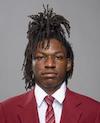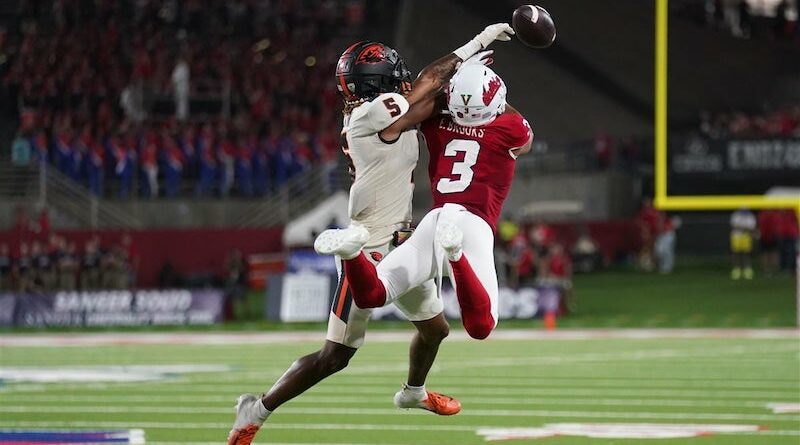
By Stephen Vilardo, SuperWest Sports
November 11, 2022
The west has several teams and individuals getting active on defense, making things difficult on the passing game of the opposition.
 Five teams in our coverage area are among the top 30 in passes defended per game this season with three of them slotting in the top 19 nationally.
Five teams in our coverage area are among the top 30 in passes defended per game this season with three of them slotting in the top 19 nationally.
Leading the way is Oregon State and their 6.11 passes defended per game, the fifth-most of any program in the country.
The Beavers have broken up or intercepted 55 passes on the season, and for good measure, the Beavs have also registered 34 QB hurries and 12 sacks on the season.
There is definitely a correlation between the two.

The QB hurries cause rushed throws and the good defense in the secondary causes more time for the rushers to get in the backfield.
Individually, four Beavers rank among the Top 50 in the nation in passes defended. Alex Austin leads them at 1.11 (33rd) while Jaydon Grant, Rejzohn Wright, and Ryan Cooper are all at 1.0 per game (t48).
Fresno State is defending 5.44 passes per game to rank 14th in the nation. The Bulldogs finished last season with 5.0 per game for the 15th most in the country.

Fresno recorded 12 PDs in their win over San Jose State and last week they had seven as they dominated Hawai’i. The Bulldogs also had two sacks and nine hurries when they hosted the Rainbow Warriors.
 It has been a true team effort in the back end of the defense for the Bulldogs as their 44 passes defended have been spread out among 16 different players. Bralyn Lux leads with eight on the season for 1.0 per game.
It has been a true team effort in the back end of the defense for the Bulldogs as their 44 passes defended have been spread out among 16 different players. Bralyn Lux leads with eight on the season for 1.0 per game.
Fresno State and Oregon State have each recorded 44 pass breakups as a team, tying them for the sixth most in the nation this season.
Arizona State ranks 19th in the nation with 5.33 passes defended per game on the season. The Sun Devils are led in that department by Ro Torrence who is 27th nationally with 1.14 passes defended per game individually.
 ASU has 10 interceptions this season and has picked off at least one pass in every game this season. They are one of just three schools in the nation with an interception in every game played this season.
ASU has 10 interceptions this season and has picked off at least one pass in every game this season. They are one of just three schools in the nation with an interception in every game played this season.
Illinois and Louisiana are the other two.
 The nine consecutive games with at least one interception is part of a much longer turnover streak for the Sun Devils as they have now forced at least one turnover in 18 straight games, the second-longest streak in the country at the moment, behind Georgia State’s 21-game run.
The nine consecutive games with at least one interception is part of a much longer turnover streak for the Sun Devils as they have now forced at least one turnover in 18 straight games, the second-longest streak in the country at the moment, behind Georgia State’s 21-game run.
Speaking of streaking, Utah has quite a streak going themselves. The Utes have had at least one interception returned for a touchdown in each of the last 19 seasons, including this season.
The streak began in 2004 and is the longest active streak in the nation. The 19-year streak is also the second longest in FBS since at least 1996.
 The only longer one belongs to Arizona State when the Sun Devils had an interception returned to the house in each of the 20 seasons from 2000-19 before seeing it end in the abbreviated 2020 season.
The only longer one belongs to Arizona State when the Sun Devils had an interception returned to the house in each of the 20 seasons from 2000-19 before seeing it end in the abbreviated 2020 season.

This year alone the Utes have had three pick-sixes this season with two coming from Clark Phillips III and a third via R.J Hubert.
For Phillips, that gives him four TD returns off interceptions in his career, the second-most of any active player nationally.
The 261-return yards the Utes gained from passes thrown by the other team are the third most in the nation. Phillips has picked off five passes to share the national lead in that category with six other players.
Among players also sharing a piece of the national lead with five interceptions is Bentlee Sanders of Nevada.
While Sanders shares the mark for the most interceptions on the season with half of the Wolf Pack’s 10 on the season, things have not been as good in Reno defending the pass.
 Nevada as a team is averaging just 3.44 passes defended per game to rank 109th in the nation.
Nevada as a team is averaging just 3.44 passes defended per game to rank 109th in the nation.
UNLV has intercepted 13 passes this season, the seventh most in the country. The Rebels have taken two of those errant passes to the house this season.
Much like their rivals, while UNLV has gotten interceptions at a high rate on the season, they only have 3.89 passes defended per outing. That is 84th in the nation and stems from just 22 pass breakups in nine games.
 USC has 14 interceptions on the season, good for the third-most in the country, which equals their total from last season. The Trojans also lead the nation with 312 interception return yards.
USC has 14 interceptions on the season, good for the third-most in the country, which equals their total from last season. The Trojans also lead the nation with 312 interception return yards.

Calen Bullock has over half of those yards himself with an NCAA-leading 161 yards on his three interceptions this season with one of them getting taken to the house.
Along with the 14 picks this season, USC has added 31 pass breakups as a team for 5.00 passes defended per game, 26th in the country. A year ago, the Trojans were 104th in the nation in the same category.
California and San Diego State each ended the 2021 season in the Top 10 in passes defended per game.
 The Aztecs were third with 5.57 per outing and the Bears 5.33 per outing for the seventh most in America. This year Cal has fallen to 97th with 3.67. SDSU has dropped off, but far less ranking 38th with 4.67 per game.
The Aztecs were third with 5.57 per outing and the Bears 5.33 per outing for the seventh most in America. This year Cal has fallen to 97th with 3.67. SDSU has dropped off, but far less ranking 38th with 4.67 per game.
 Individually, Camby Goff of Air Force is tied for most passes defended per game among players out west with 1.22 per game with three interceptions and eight breakups in nine games for the Falcons.
Individually, Camby Goff of Air Force is tied for most passes defended per game among players out west with 1.22 per game with three interceptions and eight breakups in nine games for the Falcons.

New Mexico’s Jerrick Reed II also has 1.22 per game in nine games for the Lobos. Reed, however, has yet to pick one off. All 11 of his are via pass breakups, the fourth most passes broken up in the nation this season.
For his career, Nehemiah Shelton of San Jose State has recorded 34 passes defended with eight interceptions and 26 breakups, that total is the fifth most among active players in the country.
Jaylon Grant has nine interceptions in his career, the eighth most of any active player in the country.
Follow Stephen on Twitter @StephenVilardo and his organization @SERCenter.
Visit his website at sercstats.com.
-
Ranking the Top Offensive Line Units in the West for 2025
> The region's best groups of guards and tackles for the upcoming college football season - July 14, 2025 -
Ranking the Top Defensive Line Units in the West for 2025
> The best groups of ends, tackles, and nose tackles for the upcoming college football season - July 10, 2025 -
Ranking the Top Linebacker Units in the West for 2025
> The best groups of middle, inside, and outside LBs for the upcoming college football season - July 7, 2025

